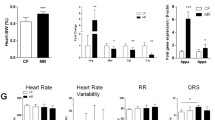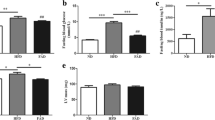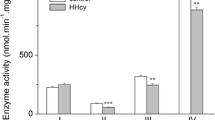Abstract
In the recent past, hyperhomocysteinemia (HHCY) has been linked to chronic heart failure. Folate and vitamin B12 deficiencies are the common causes of HHCY. The impact of these vitamins on cardiac function and morphology has scarcely been investigated. The aim of this study was to conduct an analysis of the cardiac effect of folate and vitamin B12 deficiency in vivo. Two groups of rats, a control (Co, n = 10) and a vitamin-deficient group (VitDef, n = 10), were fed for 12 weeks with a folate and vitamin B12-free diet or an equicaloric control diet. Plasma and tissue concentrations of HCY, S-adenosyl-homocysteine (SAH), S-adenosyl-methionine (SAM), and brain natriuretic peptide (BNP) were measured. Moreover, echocardiographic and histomorphometric analyses were performed. VitDef animals developed a significant HHCY (Co vs VitDef: 6.8 ± 2.7 vs 61.1 ± 12.8 μmol/l, P < 0.001). Fractional shortening, left ventricular dimension at end-diastole and end-systole, posterior wall thickness, perivascular collagen, mast cell number, and BNP tissue levels were comparable in VitDef and Co animals. Interstitial collagen (Co vs VitDef: 6.8 ± 3.0 vs 4.5 ± 2.1%, P < 0.05), plasma BNP (Co vs VitDef: 180 ± 80 vs 70 ± 60 ng/l, P < 0.05), and tissue HCY (Co vs VitDef: 0.13 ± 0.07 vs 0.07 ± 0.04 μmol/g protein, P < 0.05) were lower in VitDef animals. Folate and vitamin B12 deficiency do not affect cardiac function and morphology.



Similar content being viewed by others
References
Cleland, J. G., Khand, A., & Clark, A. (2001). The heart failure epidemic: Exactly how big is it? European Heart Journal, 22, 623–626. doi:10.1053/euhj.2000.2493.
Rosamond, W., Flegal, K., Furie, K., Go, A., Greenlund, K., Haase, N., et al. (2008). Heart disease and stroke statistics–2008 update: A report from the American Heart Association Statistics Committee and Stroke Statistics Subcommittee. Circulation, 117, e25–e146. doi:10.1161/CIRCULATIONAHA.107.187998.
Bleumink, G. S., Knetsch, A. M., Sturkenboom, M. C., Straus, S. M., Hofman, A., Deckers, J. W., et al. (2004). Quantifying the heart failure epidemic: Prevalence, incidence rate, lifetime risk and prognosis of heart failure The Rotterdam Study. European Heart Journal, 25, 1614–1619. doi:10.1016/j.ehj.2004.06.038.
Dickstein, K. (2009). ESC guidelines for the diagnosis and treatment of acute and chronic heart failure 2008: Application of natriuretic peptides. Reply. European heart journal, 30, 383.
Kenchaiah, S., Narula, J., & Vasan, R. S. (2004). Risk factors for heart failure. The Medical Clinics of North America, 88, 1145–1172. doi:10.1016/j.mcna.2004.04.016.
Vasan, R. S., Beiser, A., D’Agostino, R. B., Levy, D., Selhub, J., Jacques, P. F., et al. (2003). Plasma homocysteine and risk for congestive heart failure in adults without prior myocardial infarction. Journal of the American Medical Association, 289, 1251–1257. doi:10.1001/jama.289.10.1251.
Herrmann, M., Müller, S., Kindermann, I., Günther, L., König, J., Böhm, M., et al. (2007). Plasma B vitamins and their relation to the severity of chronic heart failure. The American Journal of Clinical Nutrition, 85, 117–123.
Herrmann, M., Kindermann, I., Müller, S., Georg, T., Kindermann, M., Böhm, M., et al. (2005). Relationship of plasma homocysteine with the severity of chronic heart failure. Clinical Chemistry, 51, 1512–1515. doi:10.1373/clinchem.2005.049841.
Nasir, K., Tsai, M., Rosen, B. D., Fernandes, V., Bluemke, D. A., Folsom, A. R., et al. (2007). Elevated homocysteine is associated with reduced regional left ventricular function: The Multi-Ethnic Study of Atherosclerosis. Circulation, 115, 180–187. doi:10.1161/CIRCULATIONAHA.106.633750.
Devi, S., Kennedy, R. H., Joseph, L., Shekhawat, N. S., Melchert, R. B., & Joseph, J. (2006). Effect of long-term hyperhomocysteinemia on myocardial structure and function in hypertensive rats. Cardiovascular Pathology, 15, 75–82. doi:10.1016/j.carpath.2005.11.001.
Joseph, J., Washington, A., Joseph, L., & Kennedy, R. H. (2004). Hyperhomocysteinaemia-induced atrial remodelling in hypertensive rats. Clinical and Experimental Pharmacology & Physiology, 31, 331–337. doi:10.1111/j.1440-1681.2004.03998.x.
Joseph, J., Washington, A., Joseph, L., Koehler, L., Fink, L. M., Hauer-Jensen, M., et al. (2002). Hyperhomocysteinemia leads to adverse cardiac remodeling in hypertensive rats. American Journal of Physiology. Heart and Circulatory Physiology, 283, H2567–H2574.
Joseph, J., Joseph, L., Shekhawat, N. S., Devi, S., Wang, J., Melchert, R. B., et al. (2003). Hyperhomocysteinemia leads to pathological ventricular hypertrophy in normotensive rats. American Journal of Physiology. Heart and Circulatory Physiology, 285, H679–H686.
Herrmann, M., Taban-Shomal, O., Hübner, U., Pexa, A., Kilter, H., Umanskaya, N., et al. (2007). Hyperhomocysteinemia and myocardial expression of brain natriuretic peptide in rats. Clinical Chemistry, 53, 773–780. doi:10.1373/clinchem.2006.077859.
Stanger, O., Herrmann, W., Pietrzik, K., Fowler, B., Geisel, J., Dierkes, J., et al. (2003). DACH-LIGA homocystein (german, austrian and swiss homocysteine society): Consensus paper on the rational clinical use of homocysteine, folic acid and B-vitamins in cardiovascular and thrombotic diseases: Guidelines and recommendations. Clinical Chemistry and Laboratory Medicine, 41, 1392–1403. doi:10.1515/CCLM.2003.214.
Refsum, H., Smith, A. D., Ueland, P. M., Nexo, E., Clarke, R., McPartlin, J., et al. (2004). Facts and recommendations about total homocysteine determinations: An expert opinion. Clinical Chemistry, 50, 3–32. doi:10.1373/clinchem.2003.021634.
Gonzalez-Gross, M., Sola, R., Albers, U., Barrios, L., Alder, M., Castillo, M. J., et al. (2007). B-vitamins and homocysteine in Spanish institutionalized elderly. International Journal for Vitamin and Nutrition Research, 77, 22–33. doi:10.1024/0300-9831.77.1.22.
Herrmann, W., Herrmann, M., Joseph, J., & Tyagi, S. C. (2007). Homocysteine, brain natriuretic peptide and chronic heart failure: A critical review. Clinical Chemistry and Laboratory Medicine, 45, 1633–1644. doi:10.1515/CCLM.2007.360.
Southern, F. N., Cruz, N., Fink, L. M., Cooney, C. A., Barone, G. W., Eidt, J. F., et al. (1998). Hyperhomocysteinemia increases intimal hyperplasia in a rat carotid endarterectomy model. Journal of Vascular Surgery, 28, 909–918. doi:10.1016/S0741-5214(98)70069-2.
Junqueira, L. C., Bignolas, G., & Brentani, R. R. (1979). Picrosirius staining plus polarization microscopy, a specific method for collagen detection in tissue sections. The Histochemical Journal, 11, 447–455. doi:10.1007/BF01002772.
Joseph, J., Kennedy, R. H., Devi, S., Wang, J., Joseph, L., & Hauer-Jensen, M. (2005). Protective role of mast cells in homocysteine-induced cardiac remodeling. American Journal of Physiology. Heart and Circulatory Physiology, 288, H2541–H2545. doi:10.1152/ajpheart.00806.2004.
Roberts, I. S., & Brenchley, P. E. (2000). Mast cells: The forgotten cells of renal fibrosis. Journal of Clinical Pathology, 53, 858–862. doi:10.1136/jcp.53.11.858.
Gellekink, H., van Oppenraaij-Emmerzaal, D., van Rooij, A., Struys, E. A., den Heijer, M., & Blom, H. J. (2005). Stable-isotope dilution liquid chromatography-electrospray injection tandem mass spectrometry method for fast, selective measurement of S-adenosylmethionine and S-adenosylhomocysteine in plasma. Clinical Chemistry, 51, 1487–1492. doi:10.1373/clinchem.2004.046995.
Fukuwatari, T., Wada, H., & Shibata, K. (2008). Age-related alterations of B-group vitamin contents in urine, blood and liver from rats. Journal of Nutritional Science and Vitaminology, 54, 357–362. doi:10.3177/jnsv.54.357.
Clifford, A. J., Heid, M. K., Muller, H. G., & Bills, N. D. (1990). Tissue distribution and prediction of total body folate of rats. The Journal of Nutrition, 120, 1633–1639.
Beck, W. S. (2001). Cobalamin (Vitamin B12). In R. B. Rucker, J. W. Sutti, D. B. McCormick, & L. J. Machlin (Eds.), Handbook of Vitamins (pp. 463–512). New York: Marcel Dekker.
Troen, A. M., Lutgens, E., Smith, D. E., Rosenberg, I. H., & Selhub, J. (2003). The atherogenic effect of excess methionine intake. Proceedings of the National Academy of Sciences of the United States of America, 100, 15089–15094. doi:10.1073/pnas.2436385100.
De Vriese, A. S., Blom, H. J., Heil, S. G., Mortier, S., Kluijtmans, L. A., Van de Voorde, J., et al. (2004). Endothelium-derived hyperpolarizing factor-mediated renal vasodilatory response is impaired during acute and chronic hyperhomocysteinemia. Circulation, 109, 2331–2336. doi:10.1161/01.CIR.0000129138.08493.4D.
Herrmann, W., Quast, S., Ullrich, M., Schultze, H., Bodis, M., & Geisel, J. (1999). Hyperhomocysteinemia in high-aged subjects: Relation of B-vitamins, folic acid, renal function and the methylenetetrahydrofolate reductase mutation. Atherosclerosis, 144, 91–101. doi:10.1016/S0021-9150(99)00036-2.
Herrmann, M., Tami, A., Wildemann, B., Wolny, M., Wagner, A., Schorr, H., Taban-Shomal, O., Umanskaya, N., Ross, S., Garcia, P., Hübner, U., & Herrmann, W. (2009). Hyperhomocysteinemia induces a tissue specific accumulation of homocysteine in bone by collagen binding and adversely affects bone. Bone, 44, 467–475.
Brody Tand Shane, B. (2001). Folic Acid. In R. B. Rucker, J. W. Sutti, D. B. McCormick, & L. J. Machlin (Eds.), Handbook of Vitamins (pp. 427–462). New York: Marcel Dekker.
Acknowledgment
This study was supported by the Kompetenznetzwerk Herzinsuffizienz by the BMBF (TP11and Deutsche Forschungsgemeinschaft/Klinische Forschergruppe KFO 196) through financial grants to Michael Böhm and Heiko Kilter.
Author information
Authors and Affiliations
Corresponding author
Rights and permissions
About this article
Cite this article
Taban-Shomal, O., Kilter, H., Wagner, A. et al. The Cardiac Effects of Prolonged Vitamin B12 and Folate Deficiency in Rats. Cardiovasc Toxicol 9, 95–102 (2009). https://doi.org/10.1007/s12012-009-9038-2
Received:
Accepted:
Published:
Issue Date:
DOI: https://doi.org/10.1007/s12012-009-9038-2




